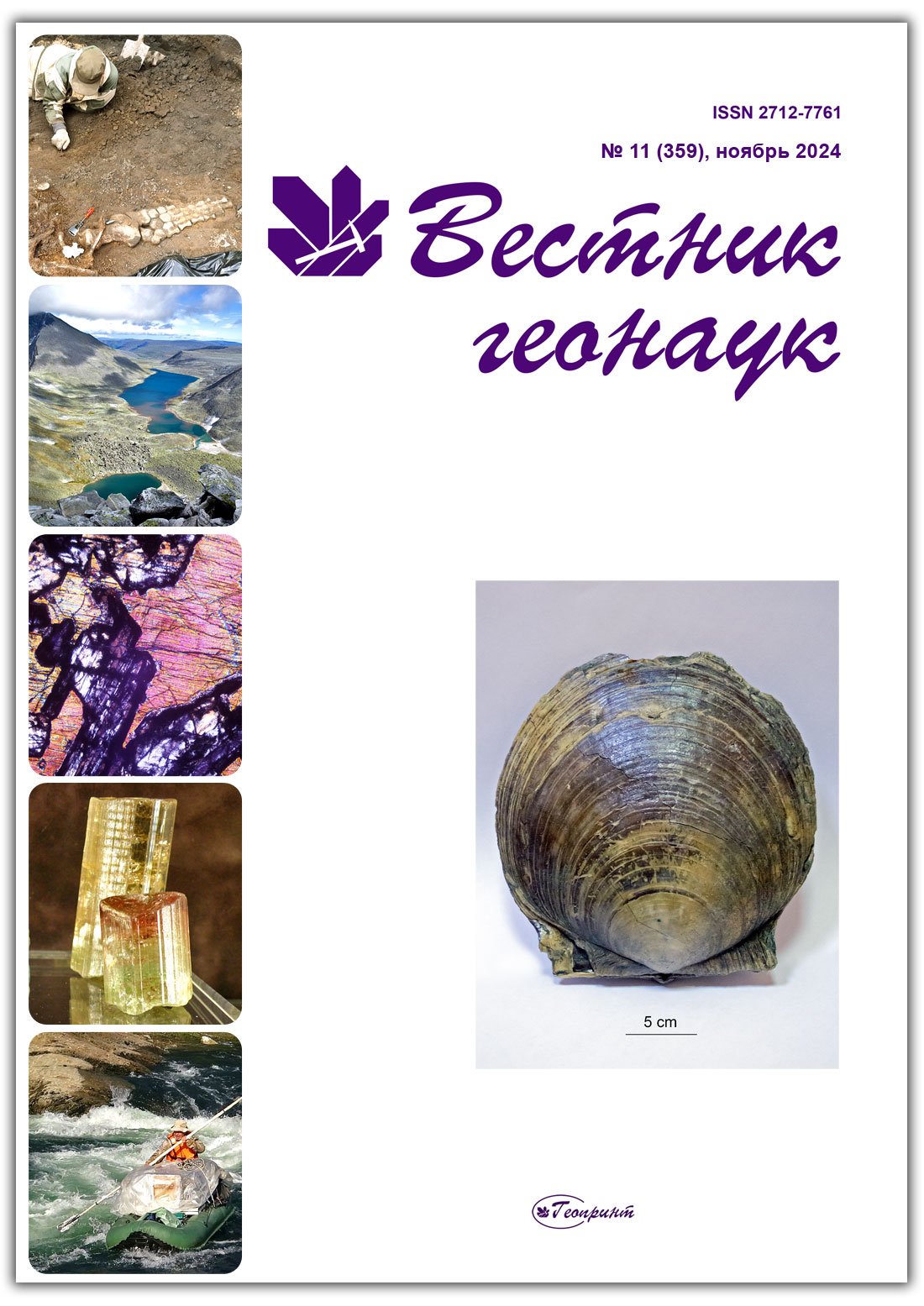|
On the cover: Early Cretaceous bivalve mollusk Camptonectes imperialis
(Keyserling, 1846), specimen No. IGKNTs 415/86. Bezmoshitsa River, Northern Timan. Photo by R. Shuktomov
|
|
| |
|
|
 Title page Title page
|
1
|
|
 Content Content
|
2
|
| |
|
|
|
|
Scientific articles
|
Buried valleys of the north-west of the East European Plain: distribution, morphology, geology and problems of genesis
A. Y. Krotova-Putintseva
DOI: 10.19110/geov.2024.11.1
A lot of buried valleys exist on the territory of the northwestern East European Plain. They are deeply cut in the pre-Quaternary rocks. The buried valleys genesis is a long-standing question of the Quaternary geology of the northwestern Russia. By now, geological data have been accumulated to solve this problem. The geological structure of the buried valleys was detailed on the basis of unpublished reports and published materials on geology of buried valleys of Saint-Petersburg, Leningrad, Pskov, Novgorod and Kaliningrad regions as well as adjacent regions of Estonia, Latvia, Lithuania and Belarus. Most of the data do not exclusively testify to river-erosion genesis of the valleys. Modern data also suggest that some of the buried valleys of the northwestern Russia are tunnel valleys and were formed by subglacial meltwater erosion as well as buried valleys of neighboring regions.
Keywords: buried valleys, pre-Quaternary surface, pre-glacial river network, subglacial erosion, tunnel valleys, Scandinavian ice sheet, north-west of the East-European Plain
 Download full text Download full text
|
3—13
|
U-Pb (SIMS) zircon chronology of intrusive magmatism
of the south-eastern part of the Izhma zone (basement of Pechora Basin)
V. L. Andreichev, A. A. Soboleva, E. G. Dovzhikova, Yu. L. Ronkin, A. N. Larionov, S. A. Sergeev, E. L. Miller, M. A. Coble
DOI: 10.19110/geov.2024.11.2
The results of local U-Pb (SIMS) zircon analysis indicate that plutonic rocks drilled by five boreholes in the Izhma zone of the Timan megablock of the Pechora Basin basement were not intruded simultaneously in the Late Precambrian. The first episode of magmatic activity took place at c. 600 Ma (at the Riphean — Vendian boundary), while the second one is confined to the Late Vendian. The ages of the granites from the 1-Nizhnyaya Omra and 1-Prilukskaya boreholes are 602 ± 2 and 593 ± 14 Ma, respectively. The granites from the 11-Malaya Pera and 1-South Djer boreholes and diorites from the 21-Palyu borehole are 557—536 Ma old, being well correlated to the 555—544 Ma old orogenic granitoids of the Pripechora fault zone (the supposed suture of the Timanides orogen).
Keywords: Pechora basin, Izhma zone, basement, granites, diorites, zircon, U-Pb age
 Download full text Download full text
|
14—29
|
Geochemistry of vesuvianite from contact-metasomatic rocks of mineral mines in the Southern Urals
V. S. Stativko, G. E. Ratkovskiy, A. B. Kuznetsov
|
30—41
|
Preparation of tetraethoxysilane for the production of monodisperse spherical silica particles. Part 3. Influence of impurity elements
D. V. Kamashev
DOI: 10.19110/geov.2024.11.4
Nanostructured 3D matrices based on monodisperse spherical silica particles are currently of considerable interest due to the prospects for their widespread use in the synthesis of new nanocomposite materials. At the same time, one of the main problems hindering their large-scale synthesis is associated with the unstable behavior of tetraethoxysilane (TEOS) during its hydrolysis and, as a result, poor reproducibility of the sizes of the formed silica particles under given conditions. In this work, based on the study of the elemental composition of impurities in silica opal matrices obtained from tetraethoxysilane from various manufacturers, we continued to study factors affecting the size of the formed particles.
To solve this problem, samples of supramolecular structures obtained from TEOS from various manufacturers were examined by the ICP-MS method for the content of impurity elements in them. It is shown that the content of elements in the initial TEOS correlates with deviations in the size of the formed silica particles. The experiments carried out on the synthesis of spherical particles with the introduction of additives of a number of previously defined elements confirm the obtained dependence. Moreover, it was found that the presence of certain impurity elements in the system increased the monodispersity of the sizes of the formed silica particles, which was a fundamentally important step to solve the problem of obtaining silica particles of a given size with high reproducibility of results. The obtained results are important for understanding the features of the formation of supramolecular structures of silica in nature.
Keywords: monodisperse spherical silica particles, supramolecular structures, physicochemical methods of analysis
 Download full text Download full text
|
42—51
|
|
|
| |
|
|
Chronicle, events, facts
|
| |
|
Wet fossils: some paleontological finds of the last field season
 Download full text Download full text |
52—56 |
| |
|
|
Her years — her wealth (celebrating the 95th anniversary of Galina Aleksandrovna Markova)
 Download full text Download full text |
57—58 |
| |
|
|
Laureate of the USSR Council of Ministers Prize
(in memory of Yury Nikolaevich Romashkin, engineer at the Institute of Geology)
 Download full text Download full text
|
58—60 |
|
|













